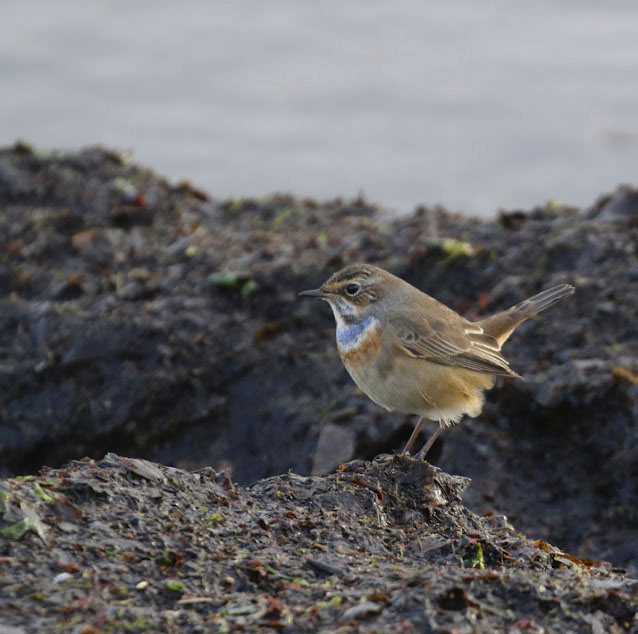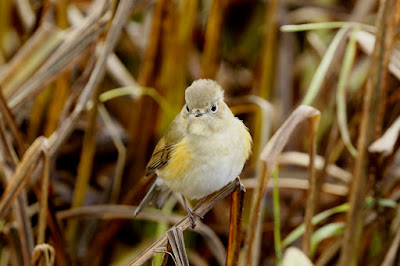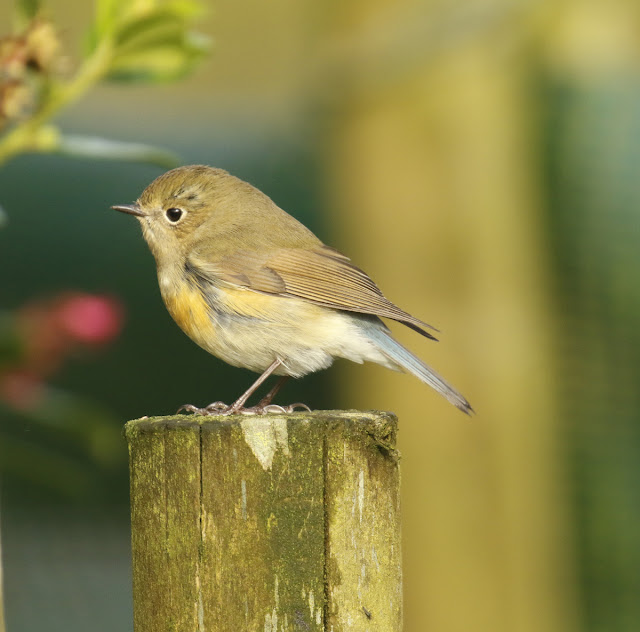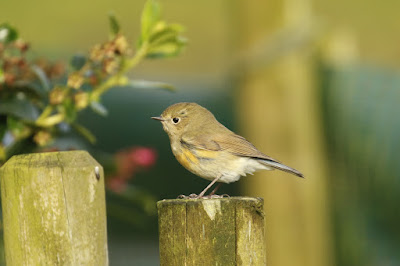Day 10
The wind was now southwest but had strengthened considerably overnight so we were back to normal. Well normal for Unst anyway. However the rain kept off so birding, although difficult in the wind, was bearable.
We looked for a Glaucous Gull that had been reported yesterday on one of the small lochs around Uyeasound but there was no sign of it, just the usual loafing flock of Great Black backed and Herring Gulls.
We did not tarry long as we wanted to get to Haroldswick Beach to try and see the Bluethroat that John and Wee George had found on the beach there yesterday. We parked by the beach and each of us took one half of the beach to cover.
According to John and Wee George, the Bluethroat was very confiding and spent its time patrolling the high tideline looking for food.With high hopes we set off along our respective section of the beach but forty minutes later we had seen nothing except a Rock Pipit. We walked the entire beach three times just in case we had missed the bird but there was nothing here. Disappointed, I walked across the road to check the wet ditch on the other side in case it was sheltering there, from the now very strong wind, but only a couple of Common Snipe rose from the ditch and flooded field beyond. There was a small hedge of wild roses running inland at a right angle from the drystone wall by the road that looked promising, so I went to the lee side of the hedge to see if anything was sheltering there. A small bird hopped out and perched in the open. Through the binoculars I could see it was just a Common Chiffchaff. Another movement came from lower down in the hedge but at first it was hard to discern what it was. Could this be the Bluethroat? The answer came soon enough when out popped a Lesser Whitethroat.
According to John and Wee George, the Bluethroat was very confiding and spent its time patrolling the high tideline looking for food.With high hopes we set off along our respective section of the beach but forty minutes later we had seen nothing except a Rock Pipit. We walked the entire beach three times just in case we had missed the bird but there was nothing here. Disappointed, I walked across the road to check the wet ditch on the other side in case it was sheltering there, from the now very strong wind, but only a couple of Common Snipe rose from the ditch and flooded field beyond. There was a small hedge of wild roses running inland at a right angle from the drystone wall by the road that looked promising, so I went to the lee side of the hedge to see if anything was sheltering there. A small bird hopped out and perched in the open. Through the binoculars I could see it was just a Common Chiffchaff. Another movement came from lower down in the hedge but at first it was hard to discern what it was. Could this be the Bluethroat? The answer came soon enough when out popped a Lesser Whitethroat.
Donald rejoined me and before we left the area I had a brief look at the impressive Skidbladner, a full sized replica of the Gokstad ship found in a Viking burial mound in Norway in 1880, and placed by the sea near to Haroldswick beach for visitors to board and look over. The original ship is thought to have been built during the reign of Harald Fairhar, who is said to have landed on Unst and after whom the bay of Haroldswick is named.
Having decided to cut our losses and go to Norwick and Valyie, we found there were lots of birds in the crop strip fields and a late Willow Warbler greeted us as it hopped along a back garden wall. I stood by the fields and waited to see what was feeding in the tangles of vegetation. As I got my eye in I could see the usual flock of Twite but also in with them were some redpolls. At first they all appeared to be Mealy Redpolls but then something alarmed the birds and they rose from the field, separating into two flocks, the Twite going one way and at least ten Mealy Redpoll circling the crop and then descending back down into the field. One chose to settle on a fence post just behind me by the road. It called a wheezy contact call over and over, the call sounding a little strange and looking through the bins I could see how white this bird was. I checked the overall frosted appearance, pure white rump and underparts and small bill. It was a Coue's Arctic Redpoll and as it rejoined the other Mealy Redpolls, the contrast between the slightly larger, greyer, more heavily streaked Mealy Redpolls and the whiter, cleaner looking Coue's Arctic Redpoll could not have been starker
 |
| The Skidbladner |
 |
| Coue's Arctic Redpoll |
 |
| Mealy Redpoll |
 |
| Brambling-female |
 |
| Haroldswick Beach |
This Bluethroat, probably a male, was particularly attractive. At this time of year they are usually less brightly coloured than this one, often being juveniles or females with little colouring on their throat and chest, just faint smudges of darker feathering. In the sunshine this bird's coloured bands positively glowed when it turned to face me, showing a combination of rich reddish chestnut and blue interspersed with black, providing a glorious splash of colour on its otherwise buff underparts. This would indicate it was probably an adult. Later, close examination of a photo showed the greater coverts were uniform in colour, another indication of adulthood.
Other birders or photographers joined me on the beach and followed the Bluethroat, scrambling for position as it moved along the beach but I decided to stay put. Rather than pursuing it I waited, snug in a hollow of the bank above the beach, surrounded by grass and looking down on a mess of tideline seaweed, like some huge dish of multi coloured tagliatelli, all red, golden, orange and brown. The Bluethroat was far away up the beach but I knew it would come back past me eventually, feeding along the stranded seaweed, and if I remained motionless it would not take alarm, and would pass very close to me and I would get my pictures.
It was not unpleasant sitting overlooking the beach, feeling isolated and quietly contemplative in the sun, looking out at a couple of Grey Seals, curious as to what was going on and come to look at these strange people following a small bird up and down the beach.They came very close. rearing up out of the water to get a better view. Ringed Plovers and Turnstones came to the beach too, looking for food in the stranded mess of seaweed and sand amongst the rocks.
 |
| Seaweed |
Donald, having returned and both of us having had a surfeit of the Bluethroat, suggested we go back to Ungirsta and the conifer plantation as a Long eared Owl had been reported from the plantation yesterday.This time I would be going in!
We crossed Jim's swampy land once more and I battled my way into the conifers. It was hard going as the trees were planted close together but there were opportunities to find spaces so I could walk an erratic course the length of the small plantation, treading on a deep bed of pine needles. I walked up and down and then up again. Donald had remained outside to see if anything flew out.
On my third pass there was a commotion above me in the top of one of the small conifers and a large dark shape flew up and out.The Long eared Owl! I left the wood and further along, the owl must have been perched in the top of another conifer, as it flew again, silhouetted against the sky as it flew back over to the other side of the plantation. There was no sign of Donald who had given up on my finding the owl and wandered off. When he returned I relayed the news to him and Donald 'went in' but failed to flush the owl again. A flock of twenty Bramblings and Chaffinches flew out of the wood but nothing else.
After this we headed for 'The Final Destination' for another cup of tea and met Dave, a friend of Donald and currently leading a bird tour. He told us of the recent arrival that afternoon of a Common Rosefinch at Norwick, so we abandoned the tea break and made full speed to Norwick.
The rosefinch had been feeding in the crop strip field and sitting on telephone wires but there was no sign of it when we got there. Donald remained by the field but I wandered up the hill to Valyie and stood, looking at the Sycamore in the garden. A rapid flicking movement alerted me to the presence of a phylloscopus warbler in the Sycamore and soon I was watching a Yellow browed Warbler flitting about at great speed, flycatching amongst the outer leaves.They are such attractive little birds, a combination of green and off white with yellow stripes and bars. It soon departed and I walked back down the hill to join Donald who told me he had been watching the rosefinch!
It has been noticeable today that there are now numbers of Redwings and Bramblings arriving on the island.
I stood once again by the field, more in hope than expectation, but eventually a mixed flock of Bramblings, Mealy Redpolls, Chaffinches and Twite rose from the field and flew to the telephone wires and there, amongst them, was the Common Rosefinch. An immature or female, its unremarkable grey plumage making it not the most charismatic of birds but hopefully it will remain for a while.
Donald told me the unwelcome news that the ferry had said they were fully booked for tomorrow night, as at this time of year many of the farms were sending livestock to markets on the mainland.We would have to 'stand by' at the terminal tomorrow evening and hope for a cancellation or someone not turning up, otherwise we would have to wait until our original booking, which was for Sunday. As rain and high winds were predicted from Thursday onwards this was not a welcome prospect.
We drove back to the hostel but I got Donald to drop me at Uyeasound Pier so I could have another try at seeing Otters but it was not to be. I walked back the mile or so to the hostel in the gloaming, a world now turning monochrome, the sea silver and the dark slivers of night creeping across the last vestiges of the day. The air off the sea smelt of salt and seaweed and I was alone on the open, lonely road with just the wind for company.
I got back to the hostel and packed most of my things, as tomorrow we would be leaving the hostel for good, going to Mainland and birding there, before attempting to get on the ferry. Donald wanted to check out a persistent but unsubstantiated rumour about a Siberian Rubythroat being seen in a cabbage field at a place called Cullavoe, just a mile south of Isbister, where we saw the Red Flanked Bluetail a couple of days ago.
Day 11
After breakfast and saying goodbye to John and Wee George, who we would see on the ferry tonight if we got on, Donald and myself loaded up the car and set off for Uyeasound for just one more chance at the Otters. They were not around but a flock of sixty plus corvids, Hooded Crows and Common Ravens, were tucking into a huge bin of fish waste from the salmon farm pens that were located out in the sea beyond the pier. It looked pretty disgusting and we left them to it. The day looked like it might be good, as after one heavy but short lived shower the sky turned blue and the land was bathed in sunshine.
We followed the route north once we were on Mainland and traversed the same wild and uninhabited landscape as a couple of days before but what a transformation had come about, as now, despite the desolate miles of moorland on either side still looming away into the distance, with the banishing of the rain, everything was illuminated by the sun. The lochs and inlets were the brightest sparkling blue and the moors were varying shades of reddish brown and dull green where the moor grasses grew. It was still windy and the occasional short lived shower kept us on our mettle. In fact, when we got to Cullavoe and had just got out of the car a vicious shower arrived out of nowhere. I dived back into the car and the rain lashed at the car windows but it passed in a few minutes. Donald, made of sterner stuff, stuck it out, walking down the road looking in gardens with a couple of other birders but he must have got soaked.
Frankly I was not too enthusiastic about chasing up a dubious rumour about a Siberian Rubythroat. Nobody had really got a definite sight of it, although someone was claiming they had a photo of it. It was all too vague for my liking and, anyway, I had seen a male at Gulberwick in Shetland in 2011 and another male in Holland last year, so was not as fired up as Donald, who had never seen one.
I had an idea, and suggested to Donald that I take the car a mile further on to Isbister and get some better photos of the Red flanked Bluetail as it was now sunny and no more showers were imminent, whilst Donald went in search of what was probably a non existent Siberian Rubythroat.
We agreed on an hour and then I would return. It took but five minutes to get to Isbister and the farmyard was still looking almost as desolate as before, even though it was sunny. I went in search of the bluetail. I tried the iris beds and found the bird almost immediately, low down, out of the wind, hopping from stem to stem, chasing insects.
 |
| The Red flanked Bluetail's favoured iris beds |
As agreed I returned to Cullavoe on time and met Donald coming down the drive of a small house.He was not happy as he had just been speaking to the man who owned the house when an Acrocephalus warbler either a Reed Warbler or a Blyth's Reed Warbler appeared in a bush in the garden just as Donald realised he had left his camera in the car with me. Maybe he was also upset as he had come to realise that the Siberian Rubythroat was a non starter (It was in fact later confirmed as a hoax).
A few words were spoken but eventually after he had calmed down I persuaded Donald that we should go back to the garden and try to re-find the warbler. We met the man at the house again, who kindly gave us permission to search the garden in the company of his two boisterous Bulldogs. After a fruitless search, we were just leaving, when one of the dogs flushed the warbler into a bush but it did not stay there long and flew off across the yard to another house nearby. We gave chase and the warbler flew from one patch of cover to another, refusing to remain still for more than a few seconds until we finally lost it when it flew around the side of a barn out of view. Donald had, remarkably, managed to get a record shot of the warbler however but we still were not sure what species it was. (Later it was confirmed as only a Reed Warbler)
It was now early afternoon and we decided that before making our way to the ferry terminal, which Donald said we should get to at 5pm, we should have another look at the Thrush Nightingale at Sandgarth, which was on our route back to Lerwick. Leaving Cullavoe I saw six Whooper Swans, two adults and four young, on a small loch and later, two Rooks feeding in a roadside field, had to be migrants. We arrived at Sandgarth to find we were the only people present and we took up position in the same place where we had watched for it before. We waited for an hour maybe, as slowly other birders arrived, including John and Wee George, but there was no sign of the Thrush Nightingale and then it was time to leave. We learnt as we left that it had moved to another part of the garden that was behind us but it was too late to do anything about it and we had to move on, so we never saw it.
We got to the ferry terminal on time and checking at the desk were told there was no problem about us getting on board! All very strange but we were hardly going to make an issue about it. A few minutes later we had our boarding cards and drove onto the ferry. An hour later we sailed from Lerwick on a beautiful, sunlit and calm evening.
My trip to Shetland had come to its conclusion and tomorrow night I would be home in Oxfordshire.
Birds seen
Northern Gannet; Great Cormorant; European Shag; Grey Heron; Mute Swan; Whooper Swan; Pink footed Goose; Greylag Goose; Eurasian Wigeon; Eurasian Teal; Mallard; Ring necked Duck; Tufted Duck; Common Goldeneye; Red breasted Merganser; White tailed Eagle; Common Kestrel; Merlin; Common Crane; Ringed Plover; European Golden Plover; Northern Lapwing; Sanderling; Purple Sandpiper; Dunlin; Ruff; Oystercatcher; Eurasian Curlew; Common Redshank; Turnstone; Arctic Skua; Long tailed Skua; Great Skua; Black headed Gull; Herring Gull; Great Black backed Gull; Common Guillemot; Black Guillemot; Rock Dove; Woodpigeon; Long eared Owl; Sky Lark; Swallow; House Martin; Olive backed Pipit; Meadow Pipit ; Red throated Pipit; Rock Pipit; Buff bellied Pipit; Dunnock; European Robin; Thrush Nightingale; Bluethroat; Red flanked Bluetail; Common Redstart; Whinchat; Northern Wheatear; Blackbird; Song Thrush; Redwing; Eurasian Reed Warbler; Barred Warbler; Lesser Whitethroat; Garden Warbler; Blackcap; Yellow browed Warbler; Common Chiffchaff; Willow Warbler; Spotted Flycatcher; Pied Flycatcher; Rook; Hooded Crow; Common Raven; Common Starling; House Sparrow; Chaffinch; Brambling; European Greenfinch; Twite; Lesser Redpoll; Mealy Redpoll; Arctic Redpoll; Parrot Crossbill; Common Rosefinch; Rustic Bunting; Little Bunting; Reed Bunting.








































No comments:
Post a Comment